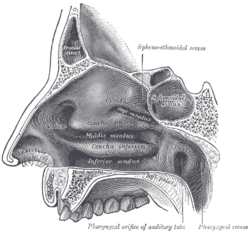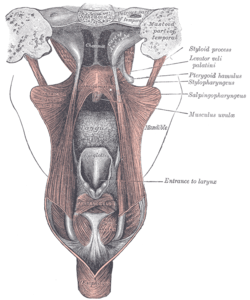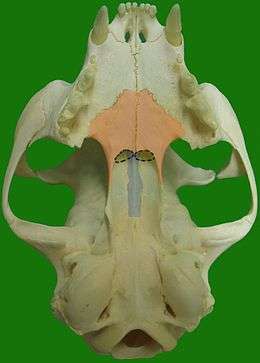Posterior nasal apertures
| Posterior nasal apertures | |
|---|---|
 Lateral wall of nasal cavity. | |
 Dissection of the muscles of the palate from behind. (Choanae visible at center top.) | |
| Details | |
| Identifiers | |
| Latin | Apertura nasalis posterior |
| TA | A06.1.02.003 |
| FMA | 76585 |

The posterior nasal apertures or internal nostrils are found at the posterior (back part) of the nasal passage between the nasal cavity and the throat in tetrapods with secondary palates, including humans and other mammals (as well as crocodilians and most skinks). In animals with secondary palates, they allow breathing when the mouth is closed.[1] They are also known as the choanae (singular choana) (from Greek χοάνη "funnel"). In tetrapods without secondary palates their function relates primarily to olfaction (sense of smell).
The choanae are separated into two parts by the vomer.
Boundaries
It is the opening between the nasal cavity and the nasopharynx.
It is therefore not a structure but a space bounded as follows:
- anteriorly and inferiorly by the horizontal plate of palatine bone,
- superiorly and posteriorly by the sphenoid bone
- laterally by the medial pterygoid plates.
- medially by the Vomer
Etymology
The term is a latinization from the Greek "choanē" meaning funnel.
Choanae in different animals
Early bony fishes (~420 mya) had two pair of nostrils, one pair for incoming water (known as the anterior or incurrent nostrils), and a second pair for outgoing water (the posterior or excurrent nostrils), with the olfactory apparatus (for sense of smell) in between. In the first tetrapodomorphs (~415 mya) the excurrent nostrils migrated to the edge of the mouth, occupying a position between the maxillary and premaxillary bones, directly below the lateral rostral (a bone that vanished in early tetrapods).[2]
In all but the most basal (primitive) tetrapodomorphs, the excurrent nostrils have migrated from the edge of the mouth to the interior of the mouth. In tetrapods that lack a secondary palate (basal tetrapods and amphibians), the choanae are located forward in the roof of the mouth, just inside the upper jaw. These internal nasal passages evolved while the vertebrates still lived in water.[3] In animals with complete secondary palates (mammals, crocodilians, most skinks) the space between the primary and secondary palates contain the nasal passages, with the choanae located above the posterior end of the secondary palate.
In animals with partial secondary palates (most birds reptiles) the median choanal slit separates the two halves of the posterior half of the palate, connecting the nasal cavity with the buccal cavity (mouth) and the pharynx (throat).[4]
Fish
Most fish do not have choanae, instead they have two pairs of external nostrils: each with two tubes whose frontal openings lie close to the upper jaw, and the posterior openings further behind near the eyes. A 395-million-year-old fossil lobe-finned fish called Kenichthys campbelli has something between a choana and the external nostrils seen on other fish. The posterior opening of the external nostrils has migrated into the mouth.[1]
In lungfish, the inner nostrils are regarded as an example of parallel evolution. The fossil lungfish Diabolepis shows an intermediate stage between posterior and interior nostril and supports the independent origin of internal nostrils in the lungfish.[1]
Hagfishes have a single internal nostril that opens inside the mouth cavity, while Chimaerae have open canals that leads water from their external nostrils into their mouths and through their gills.
Additional images
 Base of skull, inferior surface
Base of skull, inferior surface
References
- 1 2 3 Janvier, Philippe (2004) "Wandering nostrils". Nature, 432 (7013): 23–24. doi:10.1038/432023a
- ↑ Clack, Jennifer (2012). Gaining Ground: The Origin and Evolution of Tetrapods. Indiana University Press. p. 74. ISBN 0-253-35675-X. Retrieved 5 August 2015.
- ↑ Linzey, Donald W. (2012). Vertebrate Biology. JHU Press. pp. 150–1. ISBN 978-1-4214-0040-2. Retrieved 8 August 2015.
- ↑ Farner, Donald S. (22 October 2013). A. J. Marshall, ed. Biology and Comparative Physiology of Birds. Elsevier Science. p. 412. ISBN 978-1-4832-6379-3. Retrieved 8 August 2015.